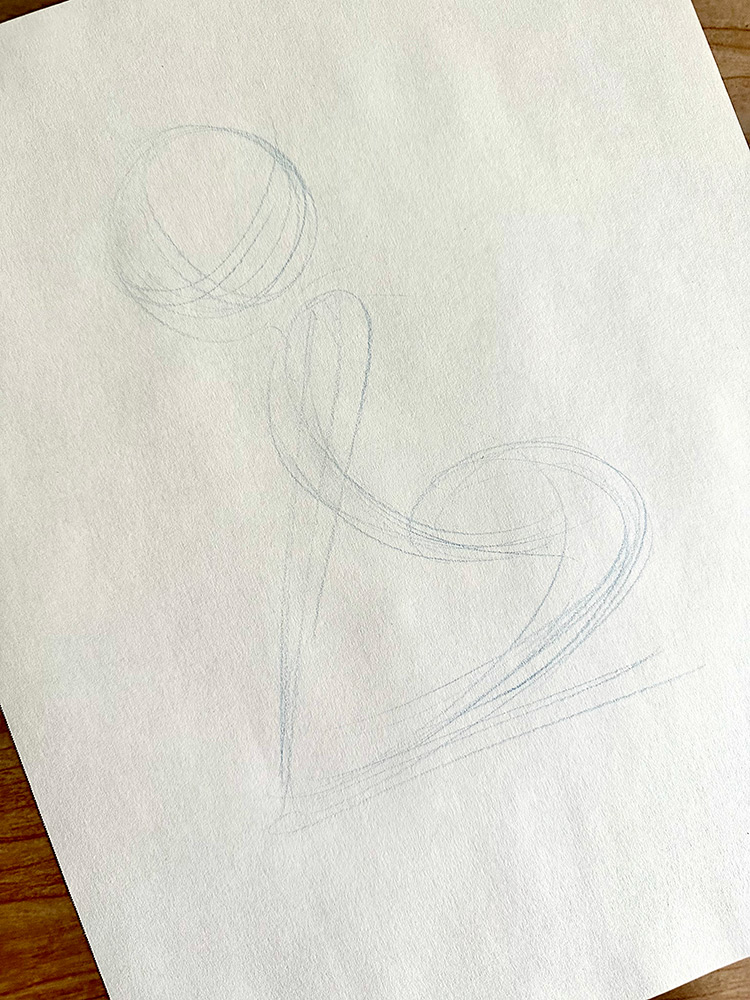We talking ’bout practice, man.
I received a message on Instagram the other day asking me about my process. My response was rather short, as I don’t often give it much thought. I draw so much that it feels less like process and more like muscle memory. That, I think, is actually the first and most important part of the process, drawing. There is no substitute for reps.
But, for those that want a slightly deeper dive, I’ll go through my steps as it relates to something like a pinup, and briefly explain what I’m doing and a bit of why I’m doing it.
I may or may not start with a posture in mind. Regardless, the first step is to get a few lines down fast. Fast is key to capturing dynamic and action while not overthinking things. I’m looking to get the torso and the limbs in roughly the position(s) I want. Here’s where reps come in. I’ve done this so many times that I know if the posture is going to work, or if the limbs are out of proportion, etc. If I get that “right” at this stage, I won’t be frustrated later as more detail goes in. A few lines are easier to erase and start over than a half-finished piece.
It might be worth noting (and this is just personal preference) that I prefer to do this initial capture with a pencil that is half worn down; both the tip and the length. I get better, faster action than if I try with a fresh pencil, and the lines are softer; meaning they are more malleable for the forms that will go on top of them.
Once I’m happy with those first few lines, I will rough-in the body shape(s). I’ll do this pretty light. Here again reps play a key role. For the most part, I can bypass having to make every section of the limbs a cylinder, connect joints with circles, etc. Those types of shapes are crucial early on as you are discovering how the body articulates, but becomes a little more intuitive after a thousand drawings.
I’ll start to go over the lines a little darker at this point. I’m starting to commit. I’m still using that half-worn pencil at this point, but I’m digging in a bit more. This is one of my last chances to fix anything really egregious.
For me, it’s pretty much love or hate at this point. I either got on the paper what I wanted, or I captured something worth finishing. I’ve thrown plenty of sketches away at this point. The good news is, I don’t have much time invested. All of this has been done relatively fast. I’ve said it here already, but it’s worth repeating; get the lines down fast. This may not be 100% universal, but I think it’s helpful, especially in the early stages of learning.
It’s full-commit time now. Here’s where I switch to a fuller-sized pencil and I get it very sharp. I’m going for it! Sharpness is critical to get small details in and to create the right weight for the lines. That latter part will be a matter of style and preference.
I’ll go heavy-handed and dig in to get the lines I want. As sections fill in, I will start to erase the lighter lines from the initial sketch. That helps tighten everything up. Note: I won’t try to capture the lines in their entirety on a first pass. I will still make lines pretty quickly, but I’ll go over and over them to build up the line and get the density I want.
Don’t worry if you mess something up here. It happens to everyone. Yes, you’ll be able to see residue of the flub, but the drawing—at least for me—is usually still worth salvaging.
About half way through this process I’ll start adding little details that weren’t in the sketch. These are often subtle, small things that are integral to my style. Don’t add them just to add them. Add them because they mean something to you.
Somewhere in those first couple passes, I’ll add costume/clothing if the piece was intended to be a specific character. If I’m finding out who this is during the sketching (which is more often than not), then those details come in later. You’ll need to work that out with what works best for you.
Lastly (usually) I’ll fill in some darks. This is to get parts of the character to “pop” off the page, and to make the whole thing feel less like a coloring book. Because of the nature of my subject, I don’t do a lot of darks on the body. I’ll do it through the costume or with dark hair or a dark background.
I repeat that process over and over and over. And, in-so-doing, I’ll adapt and adjust to what works best for me. You need to do the same. It might be very helpful to do exactly what I am doing at first, but we are always going to be different artists. Find the tools and techniques that work for you. Expand and expound on my process, or create a different one altogether. But you can only do that through reps. So, go draw something.





